ProModeler (Dragon) Fw-190G-3 modified to Fw-190G-8
Designer Kurt Tank expressed his design philosophy in creating the Fw-190 thus: “The Messerschmitt 109 [sic] and the British Spitfire, the two fastest fighters in world at the time we began work on the Fw 190, could both be summed up as a very large engine on the front of the smallest possible airframe; in each case armament had been added almost as an afterthought. These designs, both of which admittedly proved successful, could be likened to racehorses: given the right amount of pampering and easy course, they could outrun anything. But the moment the going became tough they were liable to falter. During World War I, I served in the cavalry and in the infantry. I had seen the harsh conditions under which military equipment had to work in wartime. I felt sure that a quite different breed of fighter would also have a place in any future conflict: one that could operate from ill-prepared front-line airfields; one that could be flown and maintained by men who had received only short training; and one that could absorb a reasonable amount of battle damage and still get back. This was the background thinking behind the Focke-Wulf 190; it was not to be a racehorse but a Dienstpferd, a cavalry horse.”
Thus, it was not surprising that the Fw-190, originally introduced as an air superiority fighter, would also find wide-scale use as a tactical fighter bomber. The fighter-bomber development began with the Fw 190 A-3/U3, the first Jagdbomber, which used an ETC-501 centre-line bomb rack able to carry up to 500 kg (1,100 lb) of bombs or, with horizontal stabilizing bars, one 300 L (80 US gal) standard Luftwaffe drop tank. The U3 retained the fuselage-mounted 7.92 mm MG 17s and the wing-mounted 20 mm MG 151 cannon, with the outer MG FF being removed.
The Fw-190A-4/U1 was equipped with an ETC 501 rack under the fuselage. All armament except the inner wing MG 151 cannon was removed. The Fw-190A-4/U3 was very similar to the U1, and later served as the prototype for the Fw 190 F-1 assault fighter. At this point, development of further Jadgbombers divided into what became the Fw-190F series, a front-line fighter-bomber, and the Fw-190G series, a long-range fighter-bomber.
The Fw-190A-4/U8 was the first Jabo-Rei (Jagdbomber mit vergrösserter Reichweite — abbreviated Jabo Rei, long-range fighter-bomber), adding twin standard Luftwaffe 300 L (80 US gal) drop tanks, one under each wing, on VTr-Ju 87 racks with duralumin fairings produced by Weserflug, and a centerline bomb rack. The outer wing-mounted 20 mm MG FF/M cannon and the cowling-mounted 7.92 mm were removed to save weight. The A-4/U8 was the precursor of the Fw-190G-1.
The Fw-190A-5/U2 was designed as a night Jabo-Rei and featured anti-reflective fittings and exhaust flame dampers. A centerline ETC 501 rack typically held a SC-250 kg (550 lb) bomb, and wing-mounted racks mounted 300 L drop tanks. The U2 was armed with only two 20 mm MG 151 cannon.
The Fw-190A-5/U3 was a daytime Jabo fighter fitted with ETC 501s for drop tanks and bombs; it too featured only two MG 151s for armament. This was further developed into the Fw 190 A-5/U8 which was equipped with SC-250 centerline-mounted bombs, under-wing 300-litre drop tanks and two MG 151s. Production continued as the Fw-190G-2, with the G suffix denoting the Jabo-Rei versions.
The Fw-190G-3 was based on the Fw-190A-6 airframe, with all but the two wing root mounted MG 151 cannons removed. The new V.Fw. Trg bombracks allowed the G-3 to simultaneously carry fuel tanks and bomb loads, unlike the previous aircraft.
The final version was the Fw-190G-8, based on the Fw-190A-8. It used the same "Galland" canopy as the Fw-190F-8; it was fitted with underwing ETC 503 racks that could carry either bombs or drop tanks and could carry up to the SC-500 500 kg (1,100 lb) bomb on the centerline.
On 22 June 1944, the Red Army launched Operation Bagration. The Schlachtgeschwader were a vital part of German defences. The fluid situation on the ground meant units retreated rapidly westward. Fw 190 units that employed the aircraft as jabo, became the first line of defense as German ground defenses broke down. The Fw 190 Gruppen were sent out after enemy armor spearheads that were roaming in the German rear. Usually 250 or 500 kg (550 and 1,100 lb) bombs were used. If the Soviet tanks were operating without resistance, then the targets were the soft skin supporting vehicles. Eliminating them would deny fuel and ammunition, cutting short the Soviets' advance. If the tanks were engaged with German armor, the tanks themselves would be the target to support the defense. The usual approach was made at 1,600 m (6,000 ft), above the reach of light enemy anti-aircraft fire. The Fw-190s would then drop to 4 to 10 m, dropping their loads just as the target disappeared under the nose of the fighter. The delay charge gave the German pilots about one second to get clear. At 485 k/ph (300 mph) this was usually enough. In the battles that followed, it was not uncommon for German Schlachtgeschwader pilots to fly seven or eight sorties a day. Towards the end of August fuel shortages kept the German fighters units on the ground.
The Fw-190G Jabo-Rei were used for rear-area attacks on Soviet armor and support vehicles. The jabos maintained intense activity and succeeded in inflicting heavy damage to Soviet forces. On 11 July 1944 200 Soviet vehicles were claimed by Fw 190 units. In Estonia, SG 3 and 4 claimed 400 Soviet vehicles destroyed on 28 July. The German air units helped slow down the advance into the Baltic states. In Poland, the Lvov–Sandomierz Offensive had captured bridgeheads over the Vistula river. The German air units tried to eliminate the foothold. On 28 August the Fw-190s of the Schlachtgeschwader along with Ju-87s claimed to have sunk 28 bridging ferries. The assaults failed to prevent the Soviets from continuing westward. Still, the Fw-190s of SG 2 and 77 took advantage of brief moments of air superiority to inflict heavy losses of Soviet infantry, as at times the Red Army's advance was so fast that they outran their air support, allowing the Germans a free hand.
In January 1945 the Soviets began a series of offensives in the drive to Berlin. The Lower Silesian and Upper Silesian Offensives and the vital Vistula-Oder Offensive were designed to bring the Red Army to the eastern border of Germany. The Soviets began their offensive early, to take the pressure off the Western Allies in the Ardennes. For the Fw-190 units, the initial stages were to prove tactically successful. The Soviets were forced to start offensive action under severe weather conditions. Airfields were reduced to mud-baths owing to heavy rains, and open country became impassable owing after use by large numbers of vehicles. The Red Air Force suffered more losses to accidents than combat. The Soviet armor was forced to use the few hard-surface roads to continue their advance. These routes were easily detected by German Schlachtgeschwader. The Germans, by contrast, had hard surface runways in German territory and large hangars for aircraft. On 26 January 800 vehicles, 14 tanks and 40 artillery pieces were claimed among the crammed highways. After two weeks, the offensive slowed. Fw-190 units in particular exacted a heavy toll of Soviet infantry, attacking in groups of seven to nine, unchallenged. Overall, the Germans claimed 2,000 vehicles and 51 tanks in the first three days of February. However, this came at a cost of 107 aircraft in nearly 3,000 attacks. The largest concentration of German air forces since 1940 was amassed against the Soviets, which saw the Germans gain air supremacy briefly, contributing to saving Berlin from capture sooner. The rapid construction of concrete runways allowed the Soviets to win back "air superiority". On 1 May 1945, the Soviet 16th Air Army claimed seven Fw-190s, its last victories of the war.
THE KIT
The ProMaster Fw-190G-2/3 kit is the earlier Trimaster/Dragon/DML kit, and includes the later V.Fw. Trg bombracks and two 300 L drop tanks. The kit comes with markings for a G-3 captured in Sicily and tested in the US, and a later G-3 that was repainted in the field with desert camouflage for the Sicilian campaign.
CONSTRUCTION
Both the Eduard and Trimaster Fw-190 kits are quite accurate, with the Eduard kit having finer detail. The Eduard kit includes parts to do any Fw-190 from the A-5 to the A-8, including the later fuselage gun bay cover for the 13mm machine guns, the different early and late horizontal stabilizers and elevators, early and late gear legs, and early and late wheels. Thus, whichever version one does, there are spare parts left.
I decided to use the Fw-190A-8 gun bay cover, blown canopy (the “open” option which squeezes more narrow at the base) to modify a ProModeler Fw-190G-3 to a G-8. I also found an SC-500 bomb in the spares box and decided to arm it with that weapon.
I also had Eduard cockpits and Profipack photo-etch from the earlier Eduard Fw-190s I had decided to pass on fighting with. I found the Eduard cockpit fits fine in the ProModeler fuselage. I painted it and added the photoetch instrument panels and installed it.
I then assembled the rest of the model in accordance with the instructions, adding the centerline rack and the wing racks for the drop tanks. The Eduard Fw-190A-8 gunbay cover fit with a slight bit of tweaking.
COLORS & MARKINGS
I painted the yellow theater markings and masked those off, then freehanded laste war camouflage of RLM 75/82/76. I applied a coat of clear gloss when finished. The markings came from my collection of Fw-190 spare decals, to do an anonymous airplane of an Eastern Front Schlachtgeschwader in the final battles of 1944-45.
I gave the model a coat of clear flat, then unmasked the canopies. I attached the shoulder harness, so that one fell over the side of the cockpit, then attached the Eduard canopy in the open position. I attached the landing gear, then the drop tanks, and finished off with the SC-500 bomb
CONCLUSIONS
Eduard just might go so far as to do a Fw-190G-8, but in the meantime if you have a stash of the early Dragon/DML/Trimaster kits, which are still quite nice, you can use Eduard's spare parts to come up with some of the lesser-known versions of the Wurger.
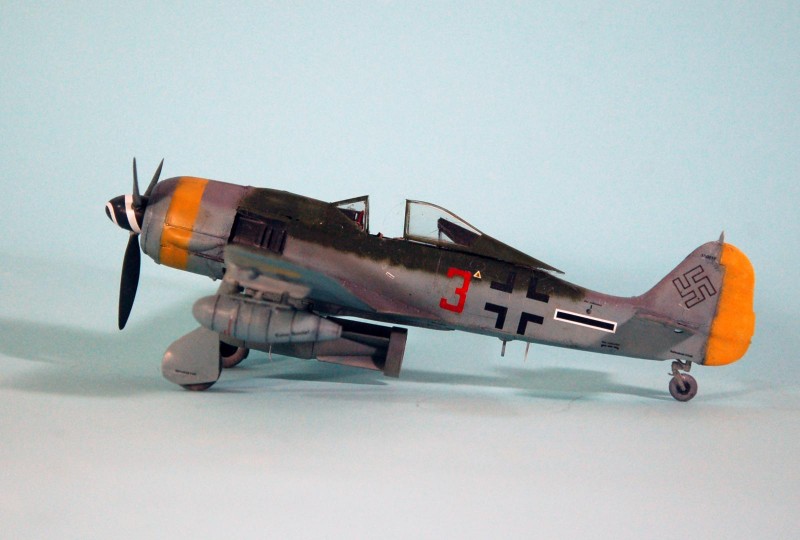
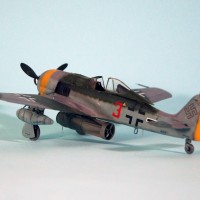
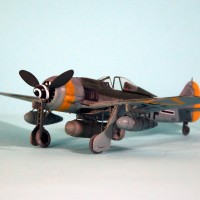

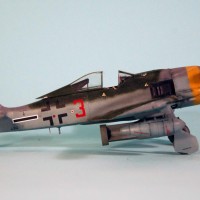
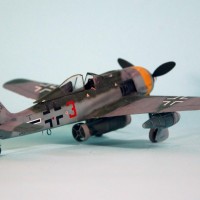
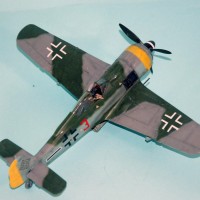
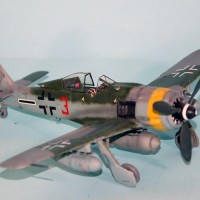
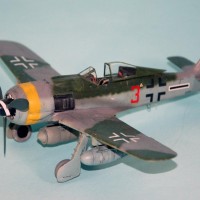
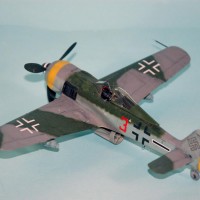
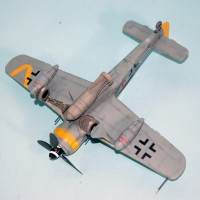
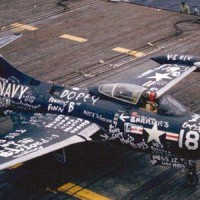
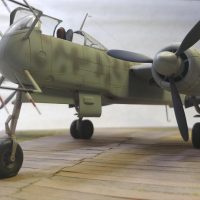
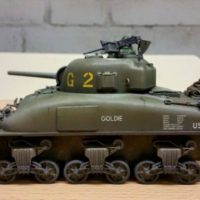
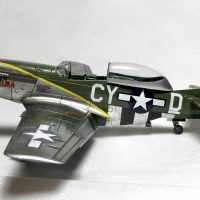
As usual, very nicely done. I really appreciated the narrative on the development and employment of the F and G models in the Jabo role because that seems to be sadly overlooked. Once again, Tom, Great Job.
Nice-lookin' build, TC...I like it.
Nice Work, Tom. Now I know the difference between a 190 F and a 190G.
Writing this taught me that also! 🙂
Very nice Tom. I like that colour combo, very different to me
Stunning as usual Tom. Thanks for sharing!
Really informative, Tom - thanks ! The FW looks great and really well done. I like the camo/colour scheme, too. Heck ... I like it all!
Bravo!
Great looking ‘G-8’, Tom. I’ve always been a ‘Dora’ man myself but this really looks the part, squat, snug nosed, dangerous - a real fighter. Like Jeff and George, I love the colo(u)ring of this example, really eye catching.
Beautifully done.
‘Liked’
... o(u) ... LoL! We Yanks have to be different! When in Rome ...
@dirtylittlefokker
Tanks philosophy was still very European in it didn't include strategic thinking, high altitude performance and flying long distances. One never reads about Fw-190's having long legs either. On the other end the P-47 was the equivalent to the Fw-190 as far as using a radial engine and carrying lots of guns to the party. But, it went beyond in distance and in altitude. Always a treat to read good writing and a little history into what is a modeling staple with a twist TC. Comfort food with a little spice.
A great build and as always, an informative post to accompany it! Amazing the thing could get off the ground hauling that load!